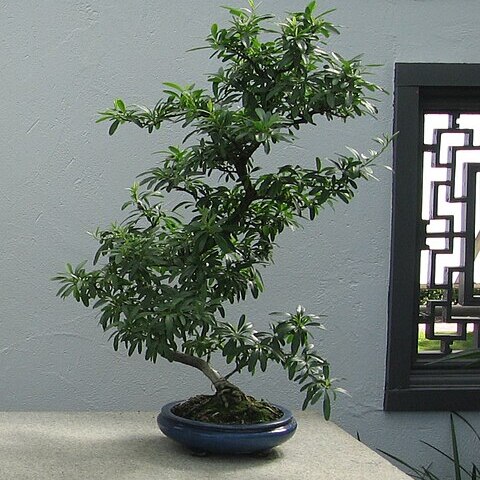Evergreen shrub up to 2-(5) m high when mature; stems very dense, spreading and spiny, often spine-tipped; very young stems greyish tomentose; older stems brown and shiny. Lf petiole 3-5 mm long, channelled above, with scattered hairs; blade narrowly oblong-obovate or narrowly oblong-elliptic, (10)-20-50-(60) × 5-12-(20) mm, usually apiculate at apex, sometimes obtuse, cuneate at base, dark green, glabrous, and ± glossy on upper surface, paler and glabrous or with scattered hairs below, serrulate along whole margin. Fls in corymbs mostly 20-40 mm across; pedicels 6-15 mm long, red, shiny, and glabrate. Sepals broad-triangular, 0.6-1.4 mm long, glabrous and shining, with a mucronulate tip. Petals broadly obovate-elliptic or suborbicular, 2.4-4 mm long, rounded, creamy white. Stamens < petals. Fr. ± depressed globose, 3-6-(7) mm wide across the top, orange-red or red, glossy.
Shrub, up to 3 m high; evergreen. Stems stiff, erect, spiny; spines woody, sharp-pointed, with leaves. Leaves simple; blade narrowly oblong or obovate, 15-30 x 5-10 mm, apex obtuse, margins crenulate-serrulate, surfaces glabrous, upper surface glossy green, lower duller. Flowers: on long, slender, glabrous, peduncles; calyx glabrous; petals ± 4 mm long, white; Sep.-Dec. Fruit an orange-red pome, 5-8 mm in diameter.
An evergreen shrub. It grows to about 3 m high. It has spines. The leaves have stalks. They are crowded on short side branches. The leaves are 1.5-5.5 cm long by 0.8-1.8 cm wide. They are oblong or oval. They narrow towards the base. They are rounded teeth. The flowers are on stalks. The flower petals are white. The fruit is round and red. They are 6 mm across.


